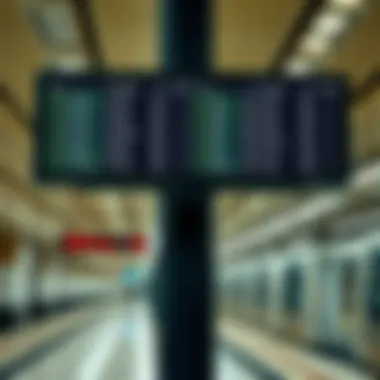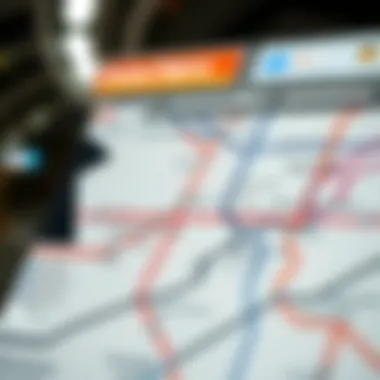Comprehensive Guide to Dubai Metro Operating Hours


Intro
With the growth of Dubai as a global hub, reliable transportation is essential. Knowing when the Metro operates can greatly influence a commuter's daily schedule, especially when one considers the city's vibrant lifestyle and the hustle of various activities from sunup to sundown. Moreover, getting a grip on these hours not only assists daily travelers but also provides insights into how the Metro contributes to the larger tapestry of public transportation in Dubai.
Arming oneself with the knowledge of the Metro’s schedule can be likened to having a cheat code for navigating this modern wonder. As we explore various aspects, readers will find valuable information to help optimize their travel experiences throughout the city.
Let's delve into the key points that will form the backbone of this article.
Overview of the Dubai Metro
The Dubai Metro stands as a testament to modern urban transport systems. It transforms the way thousands traverse the bustling metropolis each day. Understanding the operating hours of this transit marvel is pivotal not only for daily commuters but also for tourists and investors keen on grasping Dubai’s infrastructure edge.
With a metro network that stretches over 75 kilometers, the efficiency of the Dubai Metro goes beyond mere convenience. It embodies strategic urban planning designed to reduce traffic congestion and promote sustainable transport. This aspect makes it invaluable, particularly considering the rapid expansion of Dubai and the increasing population density.
Factors such as accessibility, affordability, and punctuality are intertwined with the metro’s operational schedule. As such, exploring the operating hours leads to a deeper appreciation of how the metro interconnects with other forms of transport, ultimately enhancing overall mobility in the city.
Historical Background
The inception of the Dubai Metro dates back to the early 2000s when the Dubai government recognized the need for a solution to the burgeoning traffic woes caused by rapid urbanization. Construction began in 2006, with the first line becoming operational in 2009. This was a game changer, providing an efficient mode of transport amidst a rapidly growing economy marked by construction and tourism. Over the years, the metro has undergone expansions and upgrades, showcasing Dubai's commitment to infrastructure development.
In a city known for its skyscrapers and opulence, the Metro provides an everyday approach to transport that remains highly sophisticated and innovative. The initial plan, focused on minimizing road congestion, now also aligns with global sustainability trends. With the introduction of the green line in 2011 and subsequent expansions, it is quite clear that the Metro is a cornerstone of Dubai's transport landscape.
Key Features
Several features set the Dubai Metro apart from traditional subway systems around the world.
- Driverless Technology: Dubai Metro operates without drivers, enhancing safety and efficiency.
- Two Main Lines: The Red Line and Green Line connect various parts of the city, integrating with bus routes and other transit systems.
- Aesthetic Stations: Stations are designed with a futuristic feel, some resembling glass-covered spaces filled with light.
- Smart Ticketing: The Nol Card system allows seamless travel across various modes of public transport, making it user-friendly and straightforward.
- Air-Conditioned Coaches: Unique to this region, all with climate control to ensure comfort in Dubai's often-hot weather.
In summary, the Dubai Metro not only serves as a backbone for local transportation but also stands out due to its innovation and adaptability, responding to the needs of Dubai's residents and visitors alike. Understanding its operations gives insights into the city's priorities, highlighting transport as a critical pillar of urban living.
Regular Operating Hours
Understanding the regular operating hours of the Dubai Metro is paramount for anyone navigating the city. It plays a crucial role in effective urban transportation, offering a reliable and rhythmic pulse to daily commutes. As Dubai continues to expand its infrastructure and attract a diverse population, the metro’s operational framework must align with the needs of both residents and visitors alike.
The structured hours help streamline travel for daily commuters—whether they are expats heading to work, investors visiting project sites, or tourists venturing to explore Dubai’s landmarks. Knowing when the metro is operational can significantly impact one’s daily life in terms of time management and accessibility.
Daily Schedule


The Dubai Metro operates on a meticulously planned daily schedule, designed to cater to the diverse needs of its users. Generally, the metro runs from 5:00 AM to midnight on weekdays—this schedule is crucial for early risers, such as those heading to work, and late night travelers alike.
- Monday to Thursday: 5:00 AM to 12:00 AM
- Friday: 5:00 AM to 1:00 AM (next day)
- Saturday: 6:00 AM to 1:00 AM (next day)
- Sunday: 8:00 AM to 12:00 AM
The adjustment in Saturday and Friday hours positions the metro as a flexible option for weekend activities, particularly for family outings or simply enjoying a day off. These timings not only facilitate convenience but also enhance commuter satisfaction, making public transport a competitive alternative to private vehicles.
Peak and Off-Peak Hours
Understanding the dynamics of peak and off-peak hours is pivotal for effective planning. Peak hours generally occur during the morning and evening rush hours:
- Morning Peak: 7:00 AM to 10:00 AM
- Evening Peak: 5:00 PM to 8:00 PM
During these periods, commuters are likely to find trains more crowded, as many residents head to their workplaces or return home. Knowing this allows passengers to potentially adjust their travel plans to avoid busy trains, enhancing their overall experience.
Conversely, off-peak hours, defined as times outside the mentioned peaks, offer a more relaxed commute:
- Typically before 7:00 AM and after 10:00 AM in the morning, and before 5:00 PM and after 8:00 PM in the evening.
During off-peak times, there’s greater availability of space in the carriages, making it easier for travelers to find seats or move around with luggage. Moreover, this can offer a more tranquil travel experience, allowing for a moment to relax before heading to the next destination.
The schedules of the Dubai Metro are not just operational guidelines; they reflect a commitment to meet the evolving demands of a growing metropolis, enhancing the quality of life for its inhabitants and fostering economic prosperity.
Weekend and Holiday Schedules
Understanding the weekend and holiday schedules of the Dubai Metro is crucial for both regular commuters and occasional riders. The Metro system provides a lifeline for many, connecting various parts of the city seamlessly, and knowing how it operates on weekends and holidays can enhance transit planning significantly. This aspect is particularly important for expatriates, investors, and anyone looking to navigate the bustling life in Dubai.
Friday and Saturday Timings
Typically, the Metro starts operating later on Fridays. Commuters can expect services to commence from 10 AM and continue until around midnight. Saturday hours revert back to normal, with the Metro operating from 6 AM to midnight. This adjustment helps in accommodating those who attend Friday prayers and allows for a more relaxed start to the weekend.
- Friday Overview:
- Saturday Overview:
- Starts: 10 AM
- Ends: Midnight
- Starts: 6 AM
- Ends: Midnight
These timings allow the Metro to cater to various activities people partake in over the weekend, whether it's shopping, dining, or socializing. Residents and visitors alike benefit from this adjusted schedule.


Public Holidays
Public holidays present another layer of complexity regarding the Dubai Metro's operating hours. During these periods, the Metro may alter its timetable to accommodate the influx of travelers and the special needs of the community. For notable public holidays such as Eid Al Fitr, Eid Al Adha, and National Day, it is essential for commuters to check the latest schedules.
- Variable Hours:
The hours can shift significantly, with many rail systems extending their services to handle increased crowds. It’s not unusual for the Metro to operate from early morning until well into the night on festive days. - Updates and Notifications:
Information about revised hours is often announced through various channels, including the Dubai Roads and Transport Authority website. Monitoring these updates ensures that travelers are not caught off guard.
The public holiday schedules bolster the Dubai Metro’s role as an efficient transportation method during peak travel times, whether for celebrations or community events.
Impact on Commuters
Convenience and Accessibility
The Dubai Metro operates with a level of efficiency that caters to the diverse needs of its users. One of the most significant advantages is its extensive network, which is designed to facilitate seamless accessibility. The convenience of having multiple stations spread across key areas minimizes the travel time and maximizes the opportunity to explore the city. Whether one is heading to a bustling mall, an important business meeting, or cultural hotspots, the Metro provides an easy way to reach these destinations.
- Frequent Services: Regular trains operate throughout the day, which means no long waiting times. Commuters can step onto a train with relative ease, reducing the stress often associated with public transportation.
- Safety and Comfort: The modern design of the Metro ensures a safe journey. With clean facilities and well-maintained trains, users can relax during their commute.
- Connectivity: The integration of the Metro with other forms of public transport enhances the system's accessibility. Buses and trams interlink with the train system, creating a network that allows for uncomplicated transitions between different travel modes.
Planning Commutes
Effective commuting necessitates thoughtful planning, especially in a dynamic environment like Dubai. Knowing the operating hours is the first step in making the commute more manageable. It’s not just about when the Metro runs, but also how these hours fit into the larger framework of one’s daily schedule.
- Consider Peak Times: Understanding peak hours is key. During rush hours, trains may be crowded, resulting in longer travel times. Being aware of these times can lead to a more pleasant commuting experience. For instance, avoiding travel during the morning rush from 7 AM to 9 AM can save time and safeguard against crowded conditions.
- Adjusting Plans for Holidays: As noted earlier, operating hours can shift over the weekends and on public holidays. Commuters should take note of these changes to avoid last-minute hassle and ensure smooth transitions. Familiarity with holiday schedules like those on Eid can mean the difference between a well-planned outing and an unexpected wait.
- Mobile Applications and Resources: Utilizing available mobile apps or online platforms keeps commuters updated on schedules. Users can glance at real-time train availability, which adds flexibility to their plans. Having this information at one’s fingertips strengthens the entire commuting experience.
Changes to the Schedule
Understanding the changes to the Dubai Metro's schedule is crucial for both daily commuters and occasional travelers. These adjustments can greatly affect travel plans, making it essential for users to stay informed. From seasonal adjustments to necessary maintenance closures, every change is linked to enhancing the service quality and ensuring safety for all passengers. Given Dubai's rapidly growing population and tourist influx, the Metro’s ability to adapt its schedule becomes vital in maintaining efficiency and convenience.
Seasonal Adjustments
Seasonal adjustments are typical for public transport systems, especially in cities like Dubai where temperature and events significantly fluctuate throughout the year. Each summer, the impending heat can lead to altered schedules, particularly during Ramadan, when routines change for many residents. Many people tend to postpone their outings until after sunset, so the Metro accommodates this by extending its late-night service during this holy month.
- Winter Hours: When the weather cools, the demand for Metro may rise, thus adjustments are made to provide more frequent trains during peak times.
- Event-Based Schedule: Key events such as the Dubai Shopping Festival lead to additional trains running later than normal. This adaptation indicates an understanding of the city's dynamic needs.
Importantly, these seasonal changes not only aim to cater to the passengers’ comfort but also play a significant role in maximizing the overall efficiency of the Metro system. Unplanned or last-minute alterations can cause confusion; hence, transparent communication about planned seasonal changes is invaluable. Commuters are urged to periodically check for updates via official channels such as RTA's website.
Maintenance Closures
While inconvenient, maintenance closures are a necessary part of ensuring the Metro's operational safety and efficiency. These closures, which typically take place during off-peak hours or weekends, allow for critical upgrades and repairs that cannot be efficiently done while trains are running. Understanding when these closures are scheduled can help commuters effectively plan their trips.


Common maintenance activities might include:
- Track Maintenance: Regular inspections and repairs to ensure the integrity and safety of the rail system.
- System Upgrades: Implementation of new technologies that enhance security and efficiency during service.
- Train Overhauls: Regular checks and updates to the rolling stock, which include cleaning and optimizing the trains.
Additionally, the Metro informs commuters about impending closures well in advance, often through signs at stations and announcements on social media platforms, such as Twitter feeds. This proactive approach allows passengers to seek alternative travel routes or modify their plans.
In summary, both seasonal adjustments and maintenance closures are pivotal for the smooth operation of the Dubai Metro. Commuters who stay informed about these changes can navigate their journeys more successfully, making the most out of what the Metro has to offer while enjoying the comforts of reliable public transportation.
Future Developments
As the Dubai Metro continues to play a crucial role in the city’s public transport ecosystem, future developments in its operation promise to enhance overall efficiency and user experience. With population growth and increasing tourism, the need for a reliable and accessible transit system will only intensify. This section delves into two significant aspects: proposed schedule changes and expansion plans, both of which will shape the future of how residents and visitors navigate this bustling metropolis.
Proposed Schedule Changes
Critics of the existing timetable highlight that certain routes may not align with the schedules of the populous workforce. For example, businesses in key districts often operate late into the evening, leaving workers scrambling for last-minute transport. Suggestions include extending evening hours and introducing more frequent trains during peak commuting times.
- Benefits of proposed schedule changes include:
- Increased convenience for late-night workers or early risers.
- Enhanced service during high-demand periods, reducing wait times.
- Fostering a culture of public transport reliance, reducing traffic congestion.
Expansion Plans
Another vital component of the Dubai Metro's future trajectory is its expansion plans. The Dubai Roads and Transport Authority (RTA) has laid out ambitious proposals to extend metro lines to underserved areas, ensuring that more residents have easy access to the network.
Forthcoming expansions could include:
- Extending the Red Line to suburban neighborhoods that are currently not serviced, making commuting easier for many.
- New routes connecting key attractions for tourists, which could bolster the local economy and provide seamless travel experiences.
- The possibility of introducing automated or driverless trains to reduce operational costs and enhance service efficiency.
These enhancements not only represent infrastructural growth but also reflect a commitment to sustainability, as more people adopt public transport in favor of personal vehicles.
"A well-planned public transportation system is the backbone of a thriving urban environment. With these developments, the Dubai Metro is poised to elevate its role significantly." - Dubai Metro Analyst
Finale
Summary of Key Takeaways
- Daily Operations: The Dubai Metro operates seven days a week with defined schedules that cater to peak commuting times, ensuring quick and efficient transport for all.
- Holiday Variations: Special schedules come into play during public holidays or local events, which provide opportunities for gatherings and tourism, while still offering service to those who rely on public transport.
- Future Enhancements: Understanding the current operating hours can also help passengers anticipate upcoming changes and expansions in service, keeping them informed about what’s next for the Metro system.
Keeping track of the adjustments in the schedule can save a commuter's time and avoid frustration.
Importance of Understanding Schedules
Being aware of the Dubai Metro's operating hours is not merely a convenience; it represents a critical component for anyone living in or visiting the city. With the fast pace of urban life in Dubai, commuters who grasp the nuances of the Metro schedules can optimize their travel plans. Those involved in real estate, tourism, and commerce will find this information particularly valuable.
- Efficiency: Workdays often have peak hours that can see crowds, while late evenings might provide a quicker path. Knowing these times helps in choosing when to ride.
- Reduced Costs: For savvy commuters, understanding the schedules means less reliance on taxis or rideshares, potentially reducing travel expenses. When used effectively, the Metro can be both time-saving and economical.
- Cultural Insight: For visitors, recognizing the operation times offers a glimpse into local life rhythms and practices, enhancing their overall experience.















